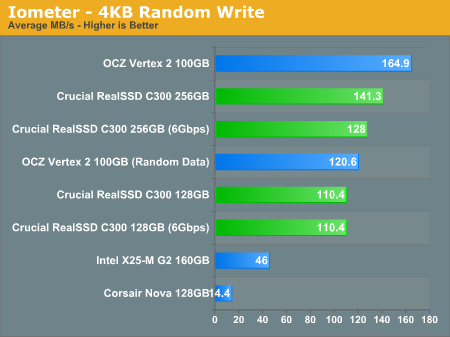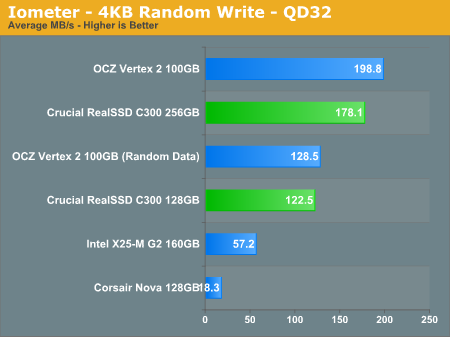The SSD Diaries: Crucial's RealSSD C300
by Anand Lal Shimpi on July 13, 2010 12:39 AM ESTRandom Read/Write Speed
The four corners of SSD performance are as follows: random read, random write, sequential read and sequential write speed. Random accesses are generally small in size, while sequential accesses tend to be larger and thus we have the four Iometer tests we use in all of our reviews.
Our first test reads/writes 4KB in a completely random pattern over an 8GB space of the drive to simulate the sort of random access that you'd see on an OS drive (even this is more stressful than a normal desktop user would see). I perform three concurrent IOs and run the test for 3 minutes. The results reported are in average MB/s over the entire time.

The C300 offers by far the best random read performance of any SSD we’ve tested. This applies to both the 256GB and 128GB versions of the C300, and while operating on a 3Gbps SATA controller. There’s a roughly 38% performance advantage over the SandForce based OCZ Vertex 2 and Intel X25-M G2. There's hardly any benefit to moving to a 6Gbps controller here as the transfer rates don't even saturate 1.5Gbps SATA.

Random write speed is similarly high, but not quite as dominant. Intel’s X25-M G2 simply shows its age here. You must keep in mind that the G2 was a mild update to the original X25-M, an architecture that was designed back in 2006 - 2007 and first sold in 2008. The X25-M G2 is simply an old architecture by today’s standards. While it makes a great value SSD, there should be no surprise that a C300 is over twice as fast in our 4KB random write test.
It’s the SandForce comparison that’s less cut and dry. By default Iometer uses data that is highly repetitive in nature. While our random test writes data to random addresses, the contents of the data itself isn’t random. The Vertex 2’s SF-1200 controller recognizes the obvious pattern in the data and just doesn’t write most of it to the drive. This is the best case scenario for the SandForce controller architecture. Now it’s absolutely a realistic workload, but not always likely.
Using a custom build of Iometer we are able to write completely random data to the drive. This data can’t be compressed and effectively defeats SandForce’s write amplification reduction algorithm. I’d argue that this scenario is even less likely than one where the data is nearly infinitely compressible, at least for a desktop user. SandForce claims that an install of Windows 7 + Office 2007 requires less than half the writes on one of its drives compared to a traditional SSD.
The point here is that while I can present performance in both cases, the real world write performance of the Vertex 2 and other SandForce drives will be somewhere in between the two numbers you see represented in the chart above. And compared to the 128GB C300, I’d say it’s likely that the Vertex 2 has the advantage in 4K random write performance. The 256GB drive improves performance enough where I’d be comfortable saying it’s probably a tossup between the two.
The 6Gbps performance is an odd story to tell here. The 128GB drive actually performs the same regardless of whether or not it's on our 6Gbps controller, however the 256GB drive takes a performance hit going to the 6Gbps controller (HighPoint Rocket 620, using the Marvell 88SE9128 controller similar to many motherboards). This is purely a fault of the controller and unfortunately one of the tradeoffs you'll have to make with the move to 6Gbps. It's very difficult to beat Intel's own SATA controller.
Many of you have asked for random write performance at higher queue depths. What I have below is our 4KB random write test performed at a queue depth of 32 instead of 3. While the vast majority of desktop usage models experience queue depths of 0 - 5, higher depths are possible in heavy I/O workloads:

While the 128GB C300 is slower than the 100GB Vertex 2, the 256GB version hangs with the SandForce posterchild. If you need the capacity, the 256GB C300 is easily a good performer even at high queue depths.










51 Comments
View All Comments
Breit - Wednesday, July 14, 2010 - link
yes, a sandforce drive should be slower in general when used with third party encryption as all data seems random to the drive then and the compression algorithms have nothing to compress. i'm not sure if the sf1200 controller can, but the sf1500 controller definitely can encrypt the data on the drive by themself storing it in an aes-128 encrypted format.quote from the sandforce site:
"DuraClass technology automatically stores data in a secure, AES-128 encrypted format. This also prevents would-be thieves from extracting data directly from the flash memory should they ever have access to the drive."
(http://www.sandforce.com/index.php?id=21&paren...
question is how good or usable their implementation is?! :)
sparkuss - Tuesday, July 13, 2010 - link
I asked this question in a previous review and once again you note your "using the Marvell 88SE9128 controller similar to many motherboards".Did you only use the WIN7 MSAHCI and INTEL IMSM 8.9 on both the onboard SATA2 and Rocket 620?
This is of interest to many on the Crucial boards concerning the lack of TRIM support in Marvell drivers for their 9123/9128 controllers.
mattgmann - Tuesday, July 13, 2010 - link
last year the ssd market was pretty cut and clear with what was good and what wasn't. There have been a lot of advances recently, and it's getting hard to keep track of what manufacturers with what controllers work well in what configurations. I'd really love to see an SSD buying guide with all of the current drives, possibly separated into workstation, laptop, and server use sections.thanks
willscary - Tuesday, July 13, 2010 - link
I just sent my first SSD back to Crucial. I called. They RMA'ed me and will send a replacement ASAP. I am impressed. I have 5 year warranties on the M225 series SSDs, and they never even blinked...send it back and they will replace it.This was the only M225 that I have installed that does not have 1916 firmware.
My comment is on the prices. If any of you recall, I was the guy who already had bought, installed and used 5 Crucial M225 128GB SSDs when I decided to try Sandforce in the OWC SSD. After I bought the SSD and ON THE DAY IT SHIPPED, OWC changed their website and said that the controllers were Sandforce 1200 and not the 1500 that I was told when I puurchased. It was still a good deal, but I was upset with the bait and switch, so I refused delivery and had it returned.
I then purchased a Crucial M225 for myself, this one the 256GB flavor.
I want to say that I have had no problems. Peak reads reach about 240MB/s and average reads are about 215MB/sec with large files. Writes are less, about 175-180MB/sec for larger files. With small files like Anand uses, my writes are about 125MB/sec and my small file reads are about 145MB/sec.
Very small files read and write much slower, in the 5-25MB/sec range, but those are files that are very small...in the 4-20KB range.
What amazes me is the speed. While 5MB/sec may sound slow, it is not, at least when you consider that these are 4KB files. These small files write and read nearly instantly.
I paid $525 for the drive. I have seen them as low as $509. This is a great price! Now that I have seen the newest article here by Anand, I really understand that my outdated M225 is still a great deal at $525.
I would like to see this drive, or a comparable one, listed in the lineup with these newer drives. While not as fast, I believe them to be a good value when sale priced. I even saw a Western Digital 128GB SSD a few weeks ago for $219 with free shipping. They were gone very quickly!
Makaveli - Tuesday, July 13, 2010 - link
That was a good read thanks.pesos - Tuesday, July 13, 2010 - link
Hi Anand,Thanks for the followup review - I have been using a 256gb C300 on each of my Poweredge T710 servers for the last few months with great results.
I am curious - does applying the destructive firmware update restore the drive to peak performance, or should it be coupled with some kind of secure erase?
Thanks,
Wes
elimliau - Wednesday, July 14, 2010 - link
Hi,Has anyone made the above work, mine cant?
Regards,
elimliau
sparkuss - Wednesday, July 14, 2010 - link
elimliau,You need to head over to the Crucial SSD forum. I have seen several threads and posts on that specific card/board.
http://forum.crucial.com/t5/Solid-State-Drives-SSD...
sparkuss - Wednesday, July 14, 2010 - link
EDIT: You may have to register to get that link to work, sorryfoo-bar - Friday, July 16, 2010 - link
This is all very interesting, and new SSDs seems to hit the market constantly. But the differences seems to be mostly software related i.e firmware. What are the bottleneck to get full SATA speed? Is it the NAND flash them selves? And if so, what is on the horizon when it comes to this type of memory?